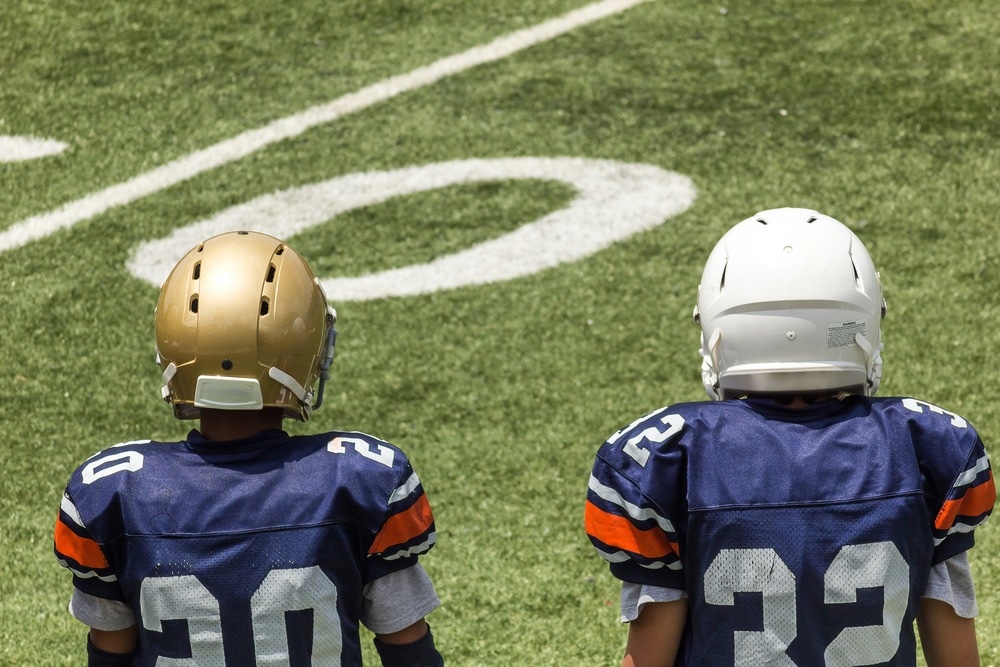In a recent study published in JAMA Network Open, researchers investigated adolescent footballer brain architecture and neurophysiological features.
 Study: Cerebral Cortical Surface Structure and Neural Activation Pattern Among Adolescent Football Players. Image Credit: Suriel Ramzal/Shutterstock.com
Study: Cerebral Cortical Surface Structure and Neural Activation Pattern Among Adolescent Football Players. Image Credit: Suriel Ramzal/Shutterstock.com
Background
The neurological impact of adolescent football players subjected to head traumas is unclear. While American football might promote teamwork, repeated subconcussive blows can cause neurological problems, particularly in young athletes.
Studies have reported that collision sports athletes have a lower cortical thickness, but current high school and college football players have higher brain volume reduction and cortical thinning in frontotemporal areas. Resting-state functional magnetic resonance imaging (RS-fMRI) functional connectivity indicated neurophysiological alterations caused by repeated head trauma.
About the study
In the present study, researchers used sophisticated neuroimaging techniques to assess brain anatomy and neurophysiology between high school football players and non-contact sports participants.
The team matched adolescent football athletes and controls engaging in non-contact sports such as tennis, swimming, and cross country from five high school sports programs based on age, school, and gender (male). They conducted neuroimaging assessments between May and July 2021 and the following year and analyzed data between February and November 2023.
The research participants were exposed to tackle football and non-contact sports. The study outcomes included structural MRI data assessed for cortical sulcal depth, thickness, gyrification, RS-fMRI data, the amplitude of low-frequency fluctuations (ALFF), resting state-functional connectivity (RS-FC), and regional homogeneity (ReHo).
The team included individuals aged 13 to 18 who were current members of a high school football team or a non-contact sports team. They excluded individuals having a history of moderate-to-severe traumatic brain injury (TBI), control athletes who had participated in organized contact sports, and MRI contraindications.
Initially, the team produced a reference volume and its skull-stripped version and co-registered the BOLD reference to T1-weighted images. They excluded individuals with head movements and frame-wise displacements exceeding 3.0 mm and 3.0 degrees from the fMRI analyses, resampling the BOLD time series onto their original, native space. The team selected the dorsolateral prefrontal cortex (DLPFC) as the region of interest (ROI) due to its involvement in brain damage. The team included age, number of prior concussions, body mass index (BMI), Patient Health Questionnaire (PHQ-9) scores for depression, Generalized Anxiety Disorder (GAD-7) scores for anxiety, and intracranial volume as variables in the study.
Results
In total, 275 males (205 footballers; 189 white individuals (92%), five Asian, and eight black or African Americans; 70 controls; 64 white individuals (92%), four Asian, and one African American or black were analyzed. The mean participant age was 16 years. The footballers exhibited significant thinning of the cortex, particularly in front-occipital regions such as the precentral gyri of the right and the superior frontal gyri of the left relative to controls.
In contrast, there was increased cortical thickness among football players in the left cingulate cortex and the caudal cingulate cortex in the posterior and anterior regions of the right brain, respectively. The football players showed higher sulcal depth compared to controls in the precuneus, precentral gyri, and cingulate cortex, especially the inferior aspect of the parietal lobe and the caudal cingulate cortical regions of the anterior aspect of the right brain.
Compared to controls, the football players showed increased gyrification in various regions of both hemispheres, including the frontoparietal areas, cingulate cortex, lingual gyrus, and precuneus. In contrast, the team observed lesser gyrification in footballer peri calcarine, superior temporal gyri, pars orbitalis gyri, and caudal cingulate cortices of the anterior brain.
The team detected significantly lower values of ALFF in the footballer cingulate cortex and frontal lobe, including the left triangular, superior, and middle frontal gyri; precentral gyrus; anterior and middle cingulate cortices; and bilateral insular regions. Contrastingly, they observed elevated ALFF in the medial occipital areas of the left brain of footballers, including the calcarine sulcus and lingual gyrus.
Similarly, the team noted significantly higher regional homogeneity in the occipitotemporal brain regions of footballers than controls, including calcarine sulcus, middle, lingual, and inferior occipital gyri, and inferior and middle temporal gyri. In contrast, the team observed significantly lower regional homogeneity in the precentral gyri of the right and left and the medial regions of the brain, including bilateral posterior and middle cingulate cortex, putamen, and insula.
Conclusion
Overall, the study found cortical thinning in frontal and occipital areas, thickening in the cingulate cortex, higher sulcal depth, and greater gyrification in adolescent footballer brains compared to controls. Local brain activity patterns revealed lower ALFF in the frontal area and higher ALFF within the occipital region. The coherence of brain signals was similar with lower ReHo in the medial and frontal areas and higher ReHo in the occipitotemporal regions. The study findings also highlighted the continuous growth and maturation of cortical gyri and sulci, essential to the developmental trajectory from childhood to adolescence.